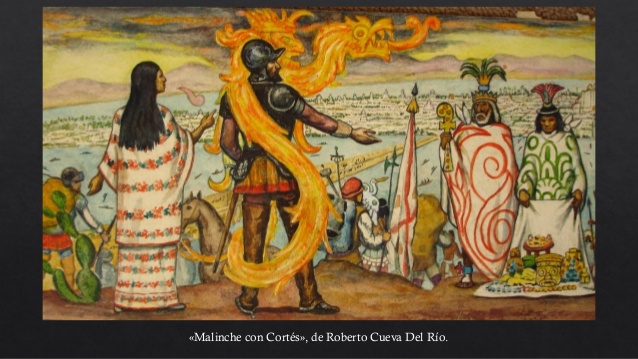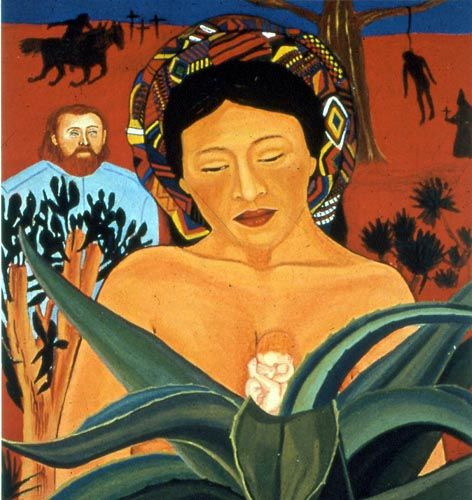Haz clic aquí para leer en español
“When I heard you were coming, I wondered why I was so willing to invite you into my home, never having met you before. I had to ask myself if it was the Maldicion de La Malinche. I questioned myself about it and decided that no, I would help anyone who walked this far.”

Malinalli was known by many names. Malinal as a girl, Marina as a Christian, Doña Marina to Cortés’men, Malintzin to the natives, though the name most widely known is La Malinche.
It is said she was a princess of the Nahua people, an indigenous group who once dominated the arid regions of Mexico and Guatemala. Today very few descendants remain who remember their language. Still, this tale of this one woman lives on after 500 years, though the telling shifts according to region, time in history, and political perspective. Just as with Hernán Cortés most either idealize or villainize her.
Born the daughter of a powerful ruler, she was cast out from her home at a tender age and sold into slavery. Rosario Castellanos tells it from Malinal’s perspective (source):
Malinche
From the throne of command my mother declared: “He is dead.”
And threw herself
into another man’s arms; the usurper and stepfather
who did not treat her with the respect
a servant renders to the majesty of a queen
but groveled in their mutual shame
of lovers and accomplices.From the Plaza of Exchange
my mother announced: “She is dead.”The scale balanced for an instant,
the chocolate bean lay motionless in the bin,
the sun remained at mid-point in the sky
as if awaiting a sign
which shot like an arrow,
becoming the sharp wail of the mourners.“The bloom of many petals was deflowered,
perfume evaporated,
torch flame burned out.A girl returns to scratch up the earth
in the place
where the midwife buried her umbilicus.She returns to the Place of Those Who Once Lived
She recognizes her father, assassinated,
ah, by poison, a dagger,
a snare before his feet, a noose.They take each other by the hand and walk,
disappearing into the fog.”Thus the wailing and lamentation
over an anonymous body: a corpse
that was not mine because I was sold
to the merchants, on my way as a slave,
a nobody, into exile.Cast out, expelled
from the kingdom, the palace, and the warm belly
of the woman who bore me in legitimate marriage bed
who hated me because I was her equal
in stature and in rank,
who saw herself in me and hating her image
dashed the mirror against the ground.I move toward destiny in chains
leaving behind all that I can still hear,
the funereal murmurs with which I am buried.And the voice of my mother in tears — in tears!
She who decrees my death.
When Cortés and his men arrived to the area in the early 1500s he was taken to be the god Quetzalcoatl, and lavished with gifts. Malinalli, said to be around 14 years old, was one of the slaves presented and Cortés gave her to his chief military strategist, Alonso.
Malintzin was a smart woman, while accounts vary as to her beauty, this one thing is held true across the tellings. Demonstrating a capacity for several of the Aztec languages and quickly learning Spanish, the men came to respect her, calling her Doña (Lady), as she earned a position as a member of Cortés’ team. She also displayed an understanding of politics, religion, and war between the tribes of the region, all very useful in the rapid overthrow of the Aztec Empire.

She was an adept negotiator between the Spaniards and the tribal chiefs, often negotiating payment in gold and preventing the slaughter of the people. Her advice was sound and insightful but she displayed a deference to Cortés, speaking only to him. Abruptly Cortés dispatched Alonso, the man to whom he had given her, as well as the group’s interpreter, back to Spain, drawing Malintzin even closer.

She became personal interpreter and lover to Cortés, traveling the country together. Grand tales of battle, betrayal, and defection color these years. Perhaps the greatest amoung them is the “Massacre of the Main Temple” and the events which transpired, ending in “La Noche Triste” (the Night of Sorrows). These tales are the material and speculation of many songs, books, operas, and films. Malinche became a character of some fixation for Frida Kahlo.

She bore him a son, Martin, loved dearly by his father and known widely as the first Mestizo. The arrival of Cortés’ Christian wife, Catalina, in Mexico, complicated the relationship and Doña Marina was eventually married to one of Cortés trusted friends. During this time she birthed a daughter, María, whom Cortés also claimed in his final will.

Doña Marina lived out her days in an estate Cortés had built for her just outside of Mexico City. It is said she succumbed to smallpox around 1551. The heritage she left yawns across centuries. Victim woman, plotting seductress, traitor, mother of modern Mexico, conqueress in her own right.
Hora del cuento: Malinche
Traducción por Henry Tovar
“Cuando escuche que venían al pueblo, me pregunte porque estaba tan dispuesta a invitarlas a mi casa, sin nunca antes habernos conocido. Tuve que preguntarme si era la maldición de la Malinche. Me cuestione acerca de ello y decidí que no, me gustaría ayudar a todo aquel que se acerque aquí”.

Malinali se conoce por muchos nombres. Malinal como una niña, Marina como cristiano. Doña Marina a Cortés´men, Malintizin a los nativos, aunque el nombre más conocido es Malinche.
Se dice que era una princesa de los pueblos nahuas, un grupo indígena que una vez dominó las regiones áridas de México y Guatemala, hoy en día sigue siendo muy pocos los descendientes que se acuerdan de esa lengua. Aun así la historia de esta mujer vive después de 500 años, a pesar de los cambios contando según la región, el tiempo en la historia, y el punto político. Al igual que con la mayoría Hernán Cortes, ya sea idealizar o villanizarla.
Nacida la hija de un poderoso gobernante, que fue lanzada fuera de su casa a una edad tierna y vendida como esclava. Rosario Castellanos lo cuenta desde la perspectiva de Malinal (Fuente):
Malinche
Desde el sillón del mando mi madre dijo: “Ha muerto”.
Y se dejó caer, como abatida,
en los brazos del otro, usurpador, padrastro
que la sostuvo no con el respeto
que el siervo da a la majestad de reina
sino con ese abajamiento mutuo
en que se humillan ambos, los amantes, los cómplices.Desde la Plaza de los Intercambios
mi madre anunció: “Ha muerto”.La balanza
se sostuvo un instante sin moverse
y el grano de cacao quedó quieto en el arca
y el sol permanecía en la mitad del cielo
como aguardando un signo
que fue, cuando partió como una flecha,
el ay agudo de las plañideras.“Se deshojó la flor de muchos pétalos,
se evaporó el perfume,
se consumió la llama de la antorcha.
Una niña regresa, escarbando, al lugar
en el que la partera depositó su ombligo.Regresa al Sitio de los que Vivieron.
Reconoce a su padre asesinado,
ay, ay, ay, con veneno, con puñal,
con trampa ante sus pies, con lazo de horca.Se toman de la mano y caminan, caminan
perdiéndose en la niebla.”Tal era el llanto y las lamentaciones
sobre algún cuerpo anónimo; un cadáver
que no era el mío porque yo, vendida
a mercaderes, iba como esclava,
como nadie, al destierro.Arrojada, expulsada
del reino, del palacio y de la entraña tibia
de la que me dio a luz en tálamo legítimo
y que me aborreció porque yo era su igual
en figura y rango
y se contempló en mí y odió su imagen
y destrozó el espejo contra el suelo.Yo avanzo hacia el destino entre cadenas
y dejo atrás lo que todavía escuchó:
los fúnebres rumores con los que se me entierra.Y la voz de mi madre con lágrimas ¡con lágrimas!
que decreta mi muerte.
Cuando Cortés y sus hombres llegaron a la zona a principios del año 1500 se consideró que era el dios Quetzalcóal, y prodigó con regalos. Malinalli, se dice que tenia 14 años de edad, fue una de las esclavas presentadas y Cortés se la dio a su feje de estrategia militar, Alonso.
Malintzin era una mujer inteligente, mientras que las cuentas varían en cuanto a su belleza, una cosa se mantiene fiel a través de las narraciones. Demostrando la capacidad de varios de los idiomas aztecas y rápido aprendizaje de español, los hombres llegaron a respetarla, llamándola Doña (Señora), se ganó un puesto como miembro del equipo de Cortés. También está representada la comprensión de la política, la religión y la guerra entre las tribus de la región, muy útil en la rápida caída del Imperio Azteca.

Ella era una negociadora hábil entre los españoles y los jefes de las tribus, a menudo negociando el pago en oro y la prevención de la masacre del pueblo. Su consejo era sonoro y perspicaz pero ella mostro una deferencia a Cortés, hablando sólo a él. De pronto, Cortés envió a Alonso, el hombre al que él la había dado, así como el interprete del grupo, de vuelta a España, dibujando a Malintzin aun más cerca.

Ella se convirtió en la intérprete personal y amante de Cortés, viajando por el país juntos. Grandes cuentos de batallas, traiciones, la deserción y el color de estos años. Tal vez la mas importante entre ellas es la “Masacre del Templo Principal” y los eventos que ocurrieron, que termina en “Noche Triste” (La noche de los dolores). Estos cuentos son la materia y la especulación de muchas canciones., libros, operas y películas. Malinche se convirtió en un personaje de cierta fijación de Frida Kahlo.

Ella le dio un hijo, Martin. Amado mucho por su padre y conocido ampliamente como el primer mestizo.
La llegada de la esposa cristiana de Cortés, Catalina, en México, complica la relación y Doña Marina eventualmente se casó con uno de los amigos más cercanos de Cortés. Durante este tiempo ella dio a luz a una hija, María, a quien Cortés también afirmó en su voluntad.

Doña maría vivió sus días en una finca que Cortés le había construido a las afueras de la Ciudad de México. Se dice que ella sucumbió a la viruela en torno a 1551. La herencia que dejó bostezos a través de los siglos. Mujer víctima, seductora conspiradora, traidora, madre del México moderno, en su propio derecho.






Comments (2)
sounds like great fodder for a book or movie – viva malinche
She was one crafty mama, for sure!